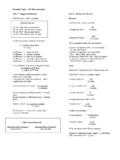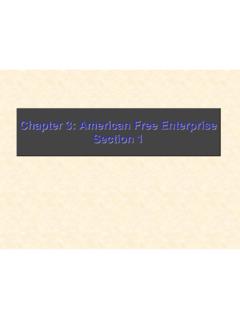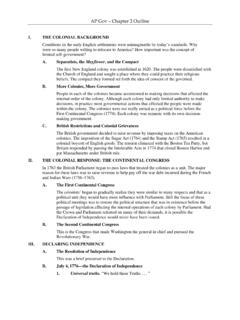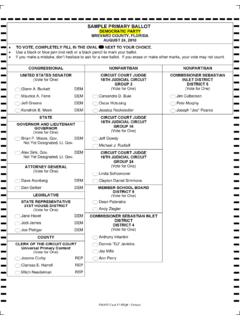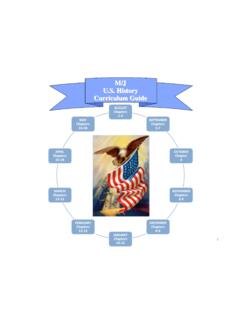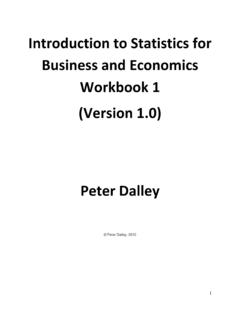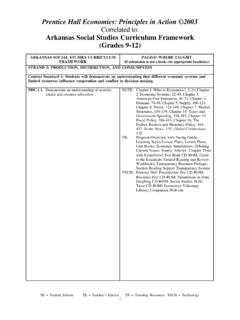Transcription of Chapter 2: Economic Systems Section 1 - jb-hdnp.org
1 Chapter 2: Economic SystemsSection 1 Chapter 2: Economic SystemsChapter 2: Economic SystemsSection 1 Section 1 Slide 2 Copyright Pearson Education, 2 Section 1 ObjectivesObjectives1. Identifythe three key Economic questions that all societies must Analyzethe societal values that determine how a country answers the three Economic Definethe characteristics of a traditional 3 Copyright Pearson Education, 2 Section 1 Key TermsKey Terms Economic system :the structure of methods and principles that a society uses to produce and distribute goods and services factor payment:the income people receive in return for supplying factors of production profit:the amount of money a business receives in excess of expenses safety net:a set of government programs that protect people who face unfavorable Economic conditions Slide 4 Copyright Pearson Education, 2 Section 1 Key Terms, Terms, cont.
2 Standard of living:level of Economic prosperity innovation:the process of bringing new methods, products, or ideas into use traditional economy:an Economic system that relies on habit, custom, or ritual to decide the three key Economic questionsSlide 5 Copyright Pearson Education, 2 Section 1 IntroductionIntroduction What goals and values affect how a society answers the key Economic questions? Each society is guided by its Economic system , which affects the way in which it does business within the society itself and with other societies. A society s values, such as freedom or tradition, guide the type of Economic system that society will 6 Copyright Pearson Education, 2 Section 1 Three Economic QuestionsThree Economic Questions As a result of scarce resources, societies must answer three key Economic questions: What goods and services should be produced?
3 How should these goods and services be produced? Who consumes these goods and services? How a society answers these three questions defines the type of Economic system that society 7 Copyright Pearson Education, 2 Section 1 Questions 1 and 2 Questions 1 and 2 What goods and services should be produced? Each society must decide what to produce in order to satisfy the needs and wants of its people. Because resources are limited, each decision that a society makes about what to produce comes at an opportunity cost. How should goods and services be produced? As a society decides how to produce its goods and services, it must consider how best to use its land, labor, and 8 Copyright Pearson Education, 2 Section 1 Combining Factor ResourcesCombining Factor ResourcesSlide 9 Copyright Pearson Education, 2 Section 1 Question 3 Question 3 Who consumes goods and services?
4 This question is largely determined by how societies distribute income. Through factor payments, including profits, societies can determine who will be the consumers of the goods and services 10 Copyright Pearson Education, 2 Section 1 Economic EfficiencyEconomic Efficiency Societies answer the three Economic questions based on the importance they attach to various Economic goals. Because resources are always scare, societies try to maximize what they can produce using the resources they have. If a society can accurately assess what to produce, it increases Economic 11 Copyright Pearson Education, 2 Section 1 Economic Freedom and SecurityEconomic Freedom and Security Some societies limit the Economic freedoms of its people. In the United States, Americans face some limitations but, in general, we enjoy a large amount of Economic freedom.
5 Economic Systems also strive to achieve a certain degree of Economic security. Ideally, Economic Systems seek to reassure people that goods and services will be available when needed and they can count on receiving expected payments on 12 Copyright Pearson Education, 2 Section 1 Economic EquityEconomic Equity Economic equity is another Economic goal that is defined differently in different societies. Each society must decide how to divide its Economic pie. Checkpoint: What are two examples of Economic goals?Slide 13 Copyright Pearson Education, 2 Section 1 Economic GrowthEconomic Growth A society also strives for Economic growth. A nation s economy must grow so it can provide jobs for the new people joining the workforce. A nation strives to improve its standards of living.
6 Innovation plays a huge role in Economic success as 14 Copyright Pearson Education, 2 Section 1 Economic Goals in ConflictEconomic Goals in Conflict There are some additional Economic goals for certain societies, including environmental protection, full employment, and protecting national industries. All societies must prioritize their Economic goals, or arrange them in order of importance. Each choice comes with some kind of 15 Copyright Pearson Education, 2 Section 1 Traditional EconomiesTraditional Economies The oldest and simplest Economic system is known as a traditional economy. Traditional economies rely on habit, custom, or ritual and revolve around the family. There is little room for innovation or 16 Copyright Pearson Education, 2 Section 1 Traditional Economies, Economies, cont.
7 Traditional economies are usually found in communities that tend to stay small and close. Often members of these societies work to support the entire community, rather than just themselves or their immediate 17 Copyright Pearson Education, 2 Section 1 Traditional Economies, Economies, cont. Societies with traditional economies are successful if they meet their own needs. In many cases, these communities lack modern conveniences and have a relatively low standard of 2: Economic SystemsSection 2 Chapter 2: Economic SystemsChapter 2: Economic SystemsSection 2 Section 2 Slide 2 Copyright Pearson Education, 2, Section 2:ObjectivesObjectives1. Explainwhy markets Analyzea circular flow model of a free market Describethe self-regulating nature of the Identifythe advantages of a free market 3 Copyright Pearson Education, 2, Section 2:Key TermsKey Terms market:any arrangement that allows buyers and sellers to exchange things specialization:the concentration of the productive efforts of individuals and businesses on a limited number of activities free market economy:an Economic system in which decisions on the three key Economic questions are based on the voluntary exchange in markets household:a person or group living in a single residenceSlide 4 Copyright Pearson Education, 2, Section 2:Key Terms, Terms, cont.
8 Firm:an organization that uses resources to produce a product or service, which it then sells factor market:the arena of exchange in which firms purchase the factors of production from households product market:the arena of exchange in which households purchase goods and services from firms self-interest:an individual s own personal gainSlide 5 Copyright Pearson Education, 2, Section 2:Key Terms, Terms, cont. incentive:the hope of reward or fear of penalty that encourages a person to behave a certain way competition:the struggle among producers for the dollars of consumers invisible hand:a term coined by Adam Smith to describe the self-regulating nature of the marketplace consumer sovereignty:the powers of consumers to decide what gets producedSlide 6 Copyright Pearson Education, 2, Section 2:IntroductionIntroduction What are the characteristics of a free market economy?
9 A free market economy is characterized by: Households and firms Factor and product markets Self-interest Competition Economic freedom, efficiency, and equitySlide 7 Copyright Pearson Education, 2, Section 2:The Purpose of MarketsThe Purpose of Markets Checkpoint: Why do markets exist? Markets, like a farmer s market, a sporting goods store, and the New York Stock Exchange, eliminate the need for any one person to be self-sufficient. Markets allow us to exchange the things we have for the things we 8 Copyright Pearson Education, 2, Section 2:SpecializationSpecialization Rather than being self-sufficient, each of us specializes in a few products or services. Specialization leads to efficient use of land, labor, and capital. Specialization allows businesses to focus on a limited number of related products or services.
10 Because of specialization, markets are needed to give people an arena with which to sell their products and to buy products that they don t produce themselves but 9 Copyright Pearson Education, 2, Section 2:Free Market EconomyFree Market Economy In a free market, answers to the three key Economic questions are made by voluntary exchange in the marketplace. Choices made by individuals determine what gets made, how it is made, and how much people can consume of the goods and services produced. In a free market system , individuals and privately owned businesses own the factors of 10 Copyright Pearson Education, 2, Section 2:Circular Flow Model of a Market EconomyCircular Flow Model of a Market EconomySlide 11 Copyright Pearson Education, 2, Section 2:Factor and Product MarketsFactor and Product Markets In an arena of exchange known as the factor market, firms purchase factors of production, such as renting land, hiring and paying workers, and borrowing money, from households.
